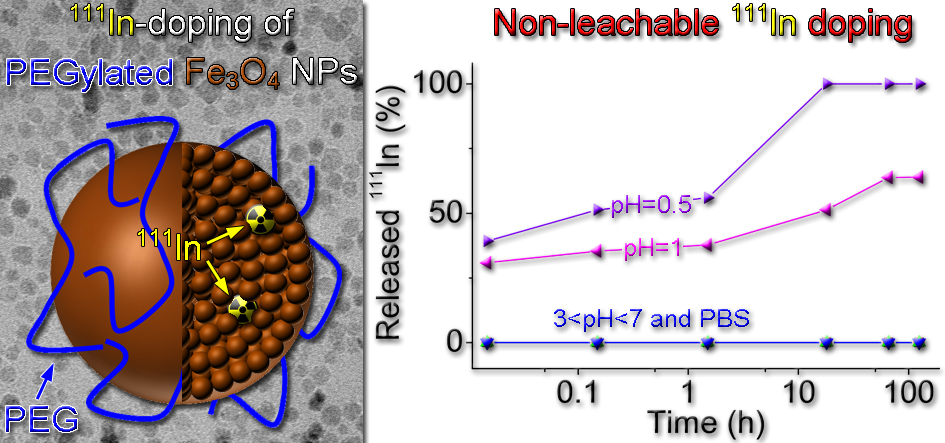| Location: Home >> News >> Research Progress | ||||
| Research Progress | ||||
| In Situ 111In-doping for Achieving Biocompatible and Non-leachable 111In-labeled Fe3O4 Nanoparticles http://www.gaomingyuan.com Tuesday, Jan 15, 2014 10:00 |
||||
 |
||||
Superparamagnetic iron oxide nanoparticles as contrast agents for magnetic resonance imaging have been intensively investigated. Nevertheless, the pharmacokinetics of iron oxide nanoparticles are rather complex and there remains a lack of in-depth studies. In principle, labeling iron oxide nanoparticles with radioactive tracers can be adopted for disclosing their pharmacokinetics, in addition to providing novel PET/MRI and SPECT/MRI dual modality imaging probes. Following on from our previous studies on “one-pot” synthesis of biocompatible Fe3O4 nanoparticles, we developed a reliable approach for achieving non-leachable and biocompatible Fe3O4 nanoparticles labeled by 111In. By pyrolyzing Fe(acac)3 in the presence of carboxylated PEG, oleylamine, and InCl3 in diphenyl ether, In-doped biocompatible Fe3O4 nanoparticles can be obtained. The resulting In-doped Fe3O4 nanoparticles possess excellent colloidal stability under Milli-Q water and physiological conditions. By replacing part of the non-radioactive InCl3 by 111InCl3, 111In-doped Fe3O4 nanoparticles can be obtained. Further investigations demonstrated that the resulting 111In-doped Fe3O4 nanoparticles possess excellent anti-leaching properties in water solutions with 2 < pH < 7 and PBS apart from excellent colloidal stability. The radioactive 111In can only be released at pH lower than 2, which is mainly caused by the decomposition of Fe3O4 nanoparticles. Most importantly, less than 0.01% of 111In are released after the resulting nanoparticle incubated in saline or FBS for 24 h, several orders of magnitude lower than those reported in the literature for radiolabeled nanoparticles. Owing to the excellent radiolabeling stability, 111In-doped Fe3O4 nanoparticles were further used for revealing the biodistribution of the PEGylated Fe3O4 nanoparticles in mice. In addition, the leaching behavior of the radioactive dopant is found to be dependent on the solubility product values of the corresponding dopant hydroxides. The low solubility product is in favor of reducing the leaching level of the dopant. The results have been accepted by Chemical Communications.
This work is a collaborated research by Prof. Mingyuan Gao’s group from Institute of Chemistry, CAS, and Prof. Fan Wang’s group from Medical Isotopes Research Center, Peking University. Jianfeng Zeng et al. |
||||